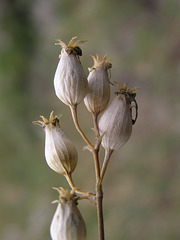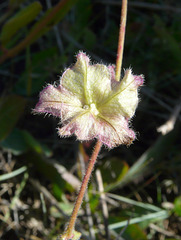Anne Elliott's photos with the keyword: Confluence Park
Bladder Campion seedpods
Leafy Musineon
| 11 May 2009 |
|
Another of our earliest wildflowers to appear - Leafy Musineon (Musineon divaricatum). This plant belongs to the Carrot family and grows from May to June in dry, open prairie grasslands. The Blackfoot used to eat the raw roots of this plant. Photographed at Confluence Park.
Rock display
| 11 May 2009 |
|
Hey, Ken, if you happen to see this shot, it's for you, LOL. I will eventually upload a few other rocks so beautifully coloured. Taken at Confluence Park yesterday afternoon. Just one of the many rocks up there, covered with brightly coloured Lichens.
Vesper Sparrow
| 02 Nov 2009 |
|
A third and final photo of this little Vesper Sparrow that we saw at Confluence Park a while ago. I'm not very likely to get another shot of this species, so thought I'd add all three to my Birds of Alberta Set.
"Vesper Sparrows are birds of dry, open areas with grass or stubble, such as grasslands, cultivated fields, pastures, roadsides, and parkland meadows. In this habitat they are common to fairly common in the southern two-thirds of Alberta except the mountains, and uncommon to scarce in the northern third." From talkaboutwildlife.ca .
Vesper Sparrow
| 19 Sep 2009 |
|
A well-cropped photo of this Vesper Sparrow, taken three days ago during a walk at Confluence Park. Oh, it feels so strange to be uploading a bird photo after all the flowers and fungi of summer! Not the greatest shot (messy on the left), but it is the first closer photo I've taken of a Vesper Sparrow. Has chestnut shoulder patch and white eye ring.
"Vesper Sparrows are birds of dry, open areas with grass or stubble, such as grasslands, cultivated fields, pastures, roadsides, and parkland meadows. In this habitat they are common to fairly common in the southern two-thirds of Alberta except the mountains, and uncommon to scarce in the northern third." From talkaboutwildlife.ca .
Invasive beauty
| 23 Sep 2009 |
|
Couldn't resist photographing this spectacular seedhead of a Goat's-beard plant that was growing at Confluence Park a week ago. This is one of our most invasive, destructive plants and it has taken over a lot of our parks and natural areas. Introduced from Eurasia. The bright yellow flower is beautiful, as is the dandelion-like seedhead, but what a huge problem it is.
Little splash of colour
| 24 Sep 2009 |
|
This little Seven-spotted Ladybug caught my eye when I was on a walk in Confluence Park a week ago.
"With approximately 35 species of Ladybug in Alberta, identifying the exact species is a bit more of a challenge. The Seven-spotted is one of our largest ladybird beetles, getting up to 7 mm long. It has seven round black spots on the elytra (modified front wings that protect the body). Immatures are rather like short caterpillars, and are dark grey with yellow spots ..... Seven-spotted Ladybird Beetles are now the most common ladybird beetle in Alberta and can be found in most habitats. These and other ladybird beetles are often encountered in large numbers in the fall when they are preparing to hibernate .... This species was originally introduced into North America from Europe in the 1950s .... The Seven-spotted Ladybird Beetle was brought in from Europe in the hope that it would help control populations of pests like aphids. It is doubtful that it has made any real difference, but what has happened is some of our native species have suffered a decline in populations since the Seven-spotted was introduced, perhaps because the Seven-spotted outcompetes them." From www.royalalbertamuseum.ca .
Brewer's Blackbird
| 15 May 2009 |
|
I managed to get close enough to this Brewer's Blackbird at Confluence Park the other day to get a closer shot than I had ever taken before. Still had to crop, though. Unfortunately, it was perched in a horrible tangle of thin branches. It does show that white eye, though, and some of the iridescent feathers. Apparently, in males, the eye colour changes to grayish white then yellow with age.
Sand Bladderpod
| 15 May 2009 |
|
This tiny, low-growing wildflower belongs to the Mustard family and grows on dry hillsides, open prairies and gravel flats. The flowers are only about 6 mm across. Grows May-July. This plant was seen at Confluence Park.
Nodding Thistle
| 13 Sep 2008 |
|
These huge Nodding Thistles are my favourite! We saw several growing at Confluence Park a couple of days ago, some in seed. Also known as Musk Thistle. Can become invasive if left where they are.
Bladder Campion
| 17 Sep 2008 |
|
Usually, when I see Campion flowers, they are either closed or in really poor condition. This one wasn't too bad, though I didn't take a very well-balanced photo of it : ). It is an introduced species from Eurasia and grows along roadsides and waste areas.
The beauty of old age
| 20 Sep 2008 |
|
Musk or Nodding Thistles are my favourite kind of thistle. These large wildflowers are magnificent when fully in bloom, but also spectacular when in seed. We saw these ones at Confluence Park. This species was introduced from Europe and North Africa and grows in overgrazed pastures and waste areas. Will become a nuisance if not pulled, as it spreads and invades.
Four o'clock
| 13 Sep 2008 |
|
We saw this unusual wildflower at Confluence Park a couple of days ago. I had seen the leaves of a plant once before, but this was the very first time I had seen a flower. This wild Four-o’clock (Mirabilis nyctaginea) has five sepals, often joined at the base, that look like petals. Four o’clock is so named because of its habit of opening in the late afternoon. It is not actually the time of day that causes the flowers to open, but the drop in temperature.
Western Meadowlark
| 31 May 2008 |
|
I was thrilled today to have the chance to get a few photos of this beautiful Western Meadowlark (who wouldn't let me get any closer)! A friend was going to Confluence Park and asked if I'd like to go along, too. So, thank you, D! Very much appreciated and enjoyed. Despite the blue sky seen in this image, a short while later the sky turned black, thunder rolled and lightning flashed and very heavy, cold rain absolutely drenched us both, LOL!
American Goldfinch
| 01 Jun 2008 |
|
Saw this beautifully bright male American Goldfinch when we went to Confluence Park yesterday afternoon. Hard to believe that the walk started off with a deep blue sky, which more than half way through the walk turned black and developed into a heavy rainstorm! In Alberta, these birds are common from late May to September and a few might overwinter.
Before the storm
| 01 Jun 2008 |
|
This was the bright blue sky over Confluence Park yesterday afternoon as clouds developed and fairly quickly turned black before a very heavy rainstorm. We were both absolutely soaked through.
Brown-headed Cowbirds
| 06 Jun 2008 |
|
Caught these three Brown-headed Cowbirds at Confluence Park, just as the sky had turned black and the first few raindrops were beginning to fall. They seem to often stretch their heads upwards like this, giving a slim look to the body. Cowbirds will lay their eggs in the nests of other birds and many of the latter will incubate the eggs as their own and then raise the young Cowbirds.
Red-sided Garter Snake
| 09 May 2008 |
|
We saw this single Red-sided Garter Snake yesterday morning at Confluence Park, while on a Botany walk. Yes, it was being gently held, but NOT by me!!! That will NEVER happen, LOL!
Jump to top
RSS feed- Anne Elliott's latest photos with "Confluence Park" - Photos
- ipernity © 2007-2025
- Help & Contact
|
Club news
|
About ipernity
|
History |
ipernity Club & Prices |
Guide of good conduct
Donate | Group guidelines | Privacy policy | Terms of use | Statutes | In memoria -
Facebook
Twitter


















